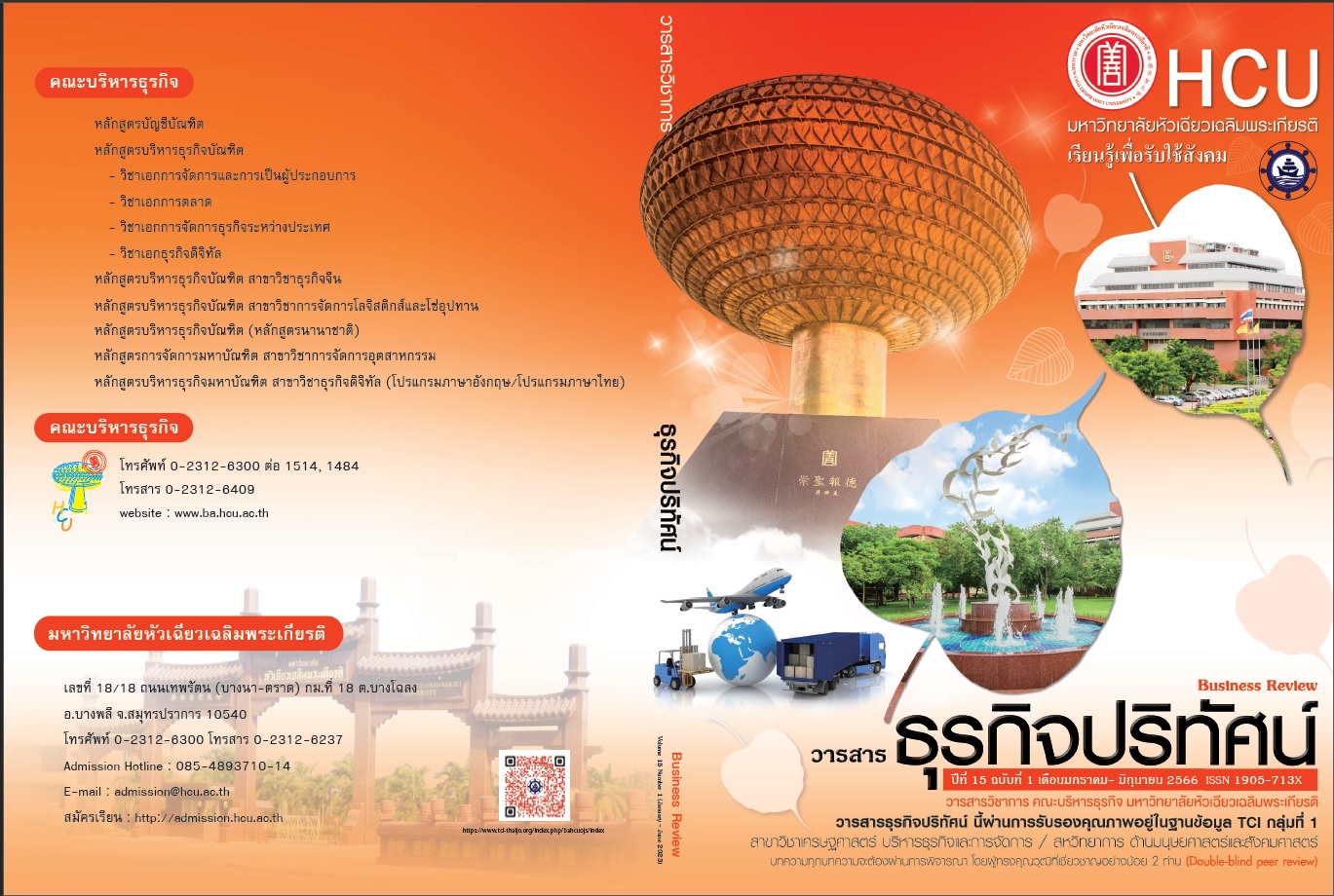ปัจจัยด้านจิตวิทยาสังคมที่มีผลต่อผลิตภัณฑ์โยเกิร์ตของผู้หญิงกลุ่มมิลเลนเนียล
คำสำคัญ:
พฤติกรรมผู้บริโภค , โยเกิร์ต , โพรไบโอติกส์ , ผู้บริโภคกลุ่มมิลเลนเนียลบทคัดย่อ
บทความวิจัยนี้มีวัตถุประสงค์เพื่อศึกษาพฤติกรรมและปัจจัยด้านจิตวิทยาเชิงสังคมที่มีผลต่อการบริโภคผลิตภัณฑ์โยเกิร์ตของผู้หญิงกลุ่มมิลเลนเนียล จากกลุ่มตัวอย่าง 266 ราย ทำการเก็บข้อมูลในช่วงเดือนมีนาคม - เดือนเมษายน 2563 โดยวิเคราะห์อิทธิพลของปัจจัยด้านจิตวิทยาเชิงสังคมที่มีต่อการบริโภคผลิตภัณฑ์โยเกิร์ตที่ผสมจุลินทรีย์โพรไบโอติกส์ในอนาคต ภายใต้กรอบทฤษฎีปฏิบัติตามแผนและวิเคราะห์ด้วยแบบจำลองเชิงโครงสร้าง ผลการศึกษาพบว่า มีเพียงปัจจัยการรับรู้ความสามารถในการควบคุมตนเองที่ส่งผลต่อความตั้งใจในการบริโภคและส่งผลทางอ้อมต่อพฤติกรรมการบริโภคผลิตภัณฑ์โยเกิร์ตในอนาคต โดยที่ปัจจัยทัศนคติและอิทธิพลของกลุ่มอ้างอิงไม่ส่งผลต่อการบริโภคผลิตภัณฑ์ดังกล่าว ข้อเสนอแนะจากผลการศึกษานี้ชี้ว่า ผู้จำหน่ายผลิตภัณฑ์โยเกิร์ตควรเน้นกลยุทธ์ด้านการตลาดผ่านร้านสะดวกซื้อ และจัดทำสื่อประชาสัมพันธ์ถึงคุณประโยชน์ของการบริโภคโยเกิร์ตเป็นประจำสำหรับผู้หญิงกลุ่มมิลเลนเนียลโดยเฉพาะ
References
ณัชญ์ธนัน พรมมา. (2558). ปัจจัยที่มีอิทธิพลต่อความตั้งในซื้ออาหารเพื่อสุขภาพของผู้บริโภค ในเขตกรุงเทพมหานคร. [วิทยานิพนธ์ปริญญามหาบัณฑิต, มหาวิทยาลัยกรุงเทพ]. DSpace at Bangkok University. http://dspace.bu.ac.th/handle/123456789/1264.
ปาริชาติ พรชนะรักษ์. (2563). คุณลักษณะและปัจจัยที่ส่งผลต่อการตัดสินใจบริโภคผลิตภัณฑ์โยเกิร์ตของผู้บริโภคกลุ่มมิลเลนเนียล. [วิทยานิพนธ์ปริญญามหาบัณฑิต, มหาวิทยาลัยเกษตรศาสตร์]. DSpace at Kasertsard University. https://ethesis.lib.ku.ac.th/dspace/handle/123456789/204.
พุทธชาติ ตัณฑิกุล. (2552). พฤติกรรมการบริโภคโยเกิร์ตแบบถ้วย กรณีศึกษาผู้บริโภคหญิงวัยรุ่นในเขตกรุงเทพมหานคร. [วิทยานิพนธ์ปริญญามหาบัณฑิต, มหาวิทยาลัยกรุงเทพ]. DSpace at Bangkok University. http://dspace.bu.ac.th/jspui/handle/123456789/457.
ศูนย์วิจัยกสิกรไทย. (2560, 19 กันยายน). เกาะกระแสสินค้าสุขภาพสร้างโอกาสธุรกิจ. ธนาคารกสิกรไทย. https://www.kasikornbank.com/th/business/sme/KSMEKnowledge/article/KSMEAnalysis/Documents/HealthyProduct.pdf.
Ajzen, I. (1991). The theory of planned behavior. Organizational Behaviour and Human Decision Process, 50: 179-211.
Anuyahong, T., Chusak, C., Thilavech, T. & Adisakwattana, S. (2020). Postprandial effect of yogurt enriched with anthocyanins from Riceberry Rice on glycemicr and antioxidant capacity in healthy adults. Nutrients 12(2930): 1-13.
Armitage, C. J. and Conner, M. (2001). Efficacy of the theory of planned behaviour: A meta-analytic review, British Journal of Social Psychology, 40: 471-499.
Bowen, N. K. & Gou, S. (2012). Structural equation modeling (pp. 141-146). New York: Oxford University Press.
Buendia, J. R., Yanping, L., Hu, F. B., Cabral, H. J., Bradlee, M. L., Quatromoni, P. A., Singer, M. R., Curhan, G. C. & Moore, L. L. (2018). Regular yogurt intake and risk of cardiovascular disease among hypertensive adults. American Journal of Hypertension, 31(5), 557-565.
Carrillo, E., V. Prado-Gascó, S. Fiszman and P. Varela. (2013). Why buying functional foods? Understanding spending behaviour through structural equation modelling. Food Research International, 50(1), 361-368.
Chuchom, T., Kiatpathomchai, S. & Thongrak, S. (2019). Yougurt consumption behavior and willingness to pay for biodegradable packaging yogurt in Hat Yai District, Songkhla Province. KKU Research Journal of Humannities and Social Sciences, 8(2), 75-87.
Crichton, G. E. and Alkerwi, A. (2014). Whole-fat dairy food intake is inversely associated with obesity prevalence: findings from the Observation of Cardiovascular Risk Factors in Luxembourg study. Nutrition Research, 34(11), 936 – 943.
De Bruijn, G.-J., S. P. Kremers, E. De Vet, J. De Nooijer, W. Van Mechelen & J. Brug. (2007). Does habit strength moderate the intention–behaviour relationship in the theory of planned behaviour? The case of fruit consumption. Psychology and Health, 22(8), 899-916.
Euromonitor International. (2019). Market Sizes. http://www.portal.euromonitor.com/portal/StatisticsEvolution/index.
Fishbein, M. & Ajzen, I. (2015). Predicting and Changing Behavior: The Reasoned Action Approach. Oxfordshire: Routledge.
Hair J. F., Black, W. C., Babin, B. J. & Anderson, R. E. (2014). Multivariate Data Analysis (7th ed.). Essex: Pearson New International Edition.
Johnson, BR & Klaenhammer, TR. (2014). Impact of genomics on the field of probiotic research: historical perspectives to modern paradigms. Antonievan Leeuwenhoek, 106, 141–56.
Kim, H., Y. Kim, H.-M. Choi & S. Ham (2018). Relationships among behavioral beliefs, past behaviors, attitudes and behavioral intentions toward healthy menu selection. Nutr Res Pract, 12(4), 348-354.
Kim, K., Reicks, M. & Sjoberg, S. (2003). Applying the theory of planned behavior to predict dairy product consumption by older adults. J Nutr Educ Behav, 35, 294-301.
Kolady D.E., Kattelmann, K. & Scaria, J. (2019). Effects of health-related claims on millennials' willingness to pay for probiotics in the US: Implications for regulation. Journal of Functional Foods, 60, 1-9.
Leardkamolkarn, V., Thongthep, W., Suttiarporn, P., Kongkachuichai, R. Wongpornchai, S. & Wanavijitr, A. (2011). Chempopreventive properties of the bran extracted from a newly-developed Thai rice: The Riceberry. Food Chemistry, 125(3), 978-985.
McFarland, L. V. (2015). From yaks to yogurt: The history, development, and current use of probiotics. Clinical Infectious Diseases, 60(suppl 2), S85–S90.
Mozaffarian, D., Hao, T., Rimm, E.B., Willett, W.C., & Hu, F.B. (2011). Changes in diet and lifestyle and long-term weight gain in women and men. N Engl J Med, 364, 2392-2404.
Nielsen S. J. & Ogen, C. (2015). Trends in yogurt consumption, US adults, 1999-2012. The FASEB, Journal, 29(Suppl 1), 587.517.
Possa, G., Corrente, J. E. & Fisberg, M. (2017). Yogurt consumption is associated with a better lifestyle in Brazilian population. BMC Nutr, 3, 29.
Ruangthammakit, O. & W. Wongsurawat (2018). Increasing growth opportunities for non-heavy and heavy users–A case study of yogurt cups in Thailand. Journal of International Food & Agribusiness Marketing, 1-26.
Sayruamyat, S. & Nadee, W. (2020, February 5-7). Impacts of social psychological factors on eating behaviour of riceberry rice based on the theory of planned behaviour: A case study in Bangkok. In T. Puttitanun & A. Lerskullawat (Chairs), Inno-creative Thailand for Sustainable Development Goals (SDGs) [Symposium]. The 58th Kasetsart University Annual conference, Bangkok, Thailand.
Tarkiainen, A. & S. Sundqvist (2005). Subjective norms, attitudes and intentions of Finnish consumers in buying organic food. British food journal, 107(11), 808-822.
Tong, X., Dong, J.Y., Wu, Z.W., Li, W. & Qin, L.Q. (2011). Dairy consumption and risk of type 2 diabetes mellitus: a meta-analysis of cohort studies. Eur J Clin Nutr, 65, 1027-1031.
Van Loo, Diem, Z. Pieniak & W. Verbeke (2013). Consumer attitudes, knowledge, and consumption of organic yogurt. Journal of dairy science, 96(4), 2118-2129.
Voon, J. P., Ngui, K. S. & Agrawal, A. (2011). Determinants of willingness to purchase organic food: An exploratory study using structural equation modeling. International Food and Agribusiness Management Review, 14(2), 103-120.
Wang, L., Manson, J.E., Buring, J.E., Lee, I.M. & Sesso, H.D. (2008). Dietary intake of dairy products, calcium, and vitamin D and the risk of hypertension in middle-aged and older women. Hypertension, 51, 1073-1079.
Downloads
เผยแพร่แล้ว
How to Cite
ฉบับ
บท
License
Copyright (c) 2023 วารสารธุรกิจปริทัศน์

This work is licensed under a Creative Commons Attribution-NonCommercial-NoDerivatives 4.0 International License.
บทความที่ได้รับการตีพิมพ์จะเป็นลิขสิทธิ์ของวารสารธุรกิจปริทัศน์
ข้อความที่ปรากฏในบทความแต่ละเรื่องในวารสารวิชาการเล่มนี้เป็นความคิดเห็นส่วนตัวของผู้เขียนแต่ละท่านไม่เกี่ยวข้องกับมหาวิทยาลัยหัวเฉียวเฉลิมพระเกียรติ และคณาจารย์ท่านอื่น ๆ ในมหาวิทยาลัยฯ แต่อย่างใด ความรับผิดชอบองค์ประกอบทั้งหมดของบทความแต่ละเรื่องเป็นของผู้เขียนแต่ละท่าน หากมีความผิดพลาดใด ๆ ผู้เขียนแต่ละท่านจะรับผิดชอบบทความของตนเองแต่ผู้เดียว




